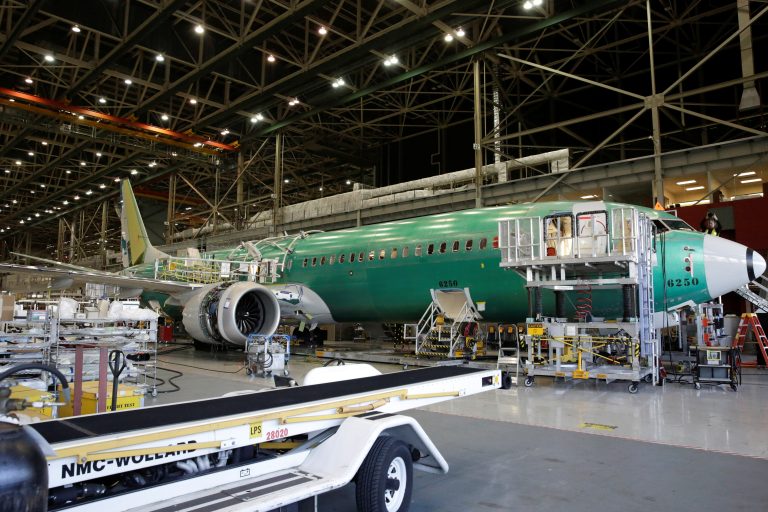On Jan. 5, The Federal Aviation Administration (FAA) ordered the temporary grounding of 171 Boeing 737 MAX 9 aircraft after an Alaska Airlines flight experienced a serious mid-flight incident.
On the evening of Jan. 5, an Alaska Airlines jetliner, flying out of Portland, blew out a portion of its fuselage just seven minutes after takeoff and nearly three miles above Oregon forcing pilots to make an emergency landing.
None of the 171 passengers or six crew members on board were injured but the rapid decompression of the cabin caused the emergency oxygen masks to drop from the ceiling.
Luckily, the two seats located near the blow out were unoccupied.
At the center of the incident is a “plug,” an unused emergency exit, which failed and left a gaping hole in the aircraft mid-flight.
Success
You are now signed up for our newsletter
Success
Check your email to complete sign up
Some airlines configure the popular jetliner to carry extra seats, which also requires the plane to have more emergency exits. Since Alaska Airlines limits its seats on the 737 MAX 9 to under 180, it does not need the extra emergency exits. Instead, the exits are replaced with a permanent “plug” the size of an exit door.
The 171 Boeing jets grounded all have the same “plug” installed.
Authorities have found the part that blew off Alaska Airlines flight 1282 on Friday in a backyard in Portland, Oregon which authorities hope will shed some light on exactly what went wrong.
READ MORE:
- Devastating Earthquake Strikes Japan on New Year’s Day as Frantic Search for Survivors Begins
- The Latest Victims of China’s Surveillance State
- ‘Heavenly’: Shen Yun Kicks Off 2024 Tour in Fort Lauderdale to Acclaimed Success
Hundreds of flights canceled
The following Sunday, Alaska Airlines canceled 170 flights and another 60 on Monday, impacting an estimated 25,000 travelers after the FAA ordered the grounding of the planes. Additional cancellations are expected during the coming week.
In a statement on Sunday, the FAA said, “They will remain grounded until the FAA is satisfied that they are safe.”
Alaska Airlines has grounded its entire fleet of 65 MAX 9 aircraft for inspections and maintenance. Initially, on Saturday, the airline kept 18 of these aircraft in service because they had recently received in-depth inspections as part of maintenance checks, but later pulled them from service to comply with an FAA directive to conduct specific inspections.
The incident prompted United Airlines, the world’s largest operator of the 737 MAX 9, to ground its entire fleet of 79 aircraft, resulting in the cancellation of 204 flights on Monday, or seven percent of all planned departures, according to FlightAware.
Alaska and United Airlines are the only two American passenger airlines that operate the aircraft. Six other international airlines use the planes including Panama’s Copa Airlines, Aeromexico, Turkish Airlines, Icelandair, FlyDubai and SCAT airlines in Kazakhstan, according to Cirium, an aviation analytics company.
According to Newsweek, Copa Airlines has temporarily grounded 21 MAX 9 planes, Aeromexico has grounded nine, and Turkish Airlines has withdrawn five aircraft.
FlyDubai and Icelandair say that their fleets are not affected by the FAA’s order, as their jetliners do not operate with the configuration referenced in the FAA’s directive.
READ MORE:
- Massive Earthquake Rocks China as Rescue Efforts Are Hampered By Frigid Temperatures
- China Deploys Spy Balloons Over Taiwan, Escalating Tensions Ahead of Key Elections
- Tesla, Other EVs Lose Tax Credits as US Hopes to Reduce Dependency on Chinese Batteries
Checkered past
This is but the most recent incident involving a Boeing aircraft.
On Sept. 30 last year, a MAX 9 United Airlines flight departing from Denver on its way to Boston experienced a fire in its number two engine while on the runway and all four tires burst on the aircraft.
Pilots successfully brought the airliner to a stop on the runway and emergency services extinguished the fire. All passengers and crew members were evacuated with no injuries.
Last December, a Boeing 737 United Airlines flight was forced to declare an emergency and return to the airport after fuel began leaking from the plane immediately after takeoff.
On March 10, 2019, an Ethiopian Airlines flight from Addis Ababa, Ethiopia to Nairobi, Kenya, crashed just six minutes after takeoff killing all 157 people aboard. The plane was only four months old at the time of the incident.
On October 29, 2018, Lion Air Flight 610, a 737 MAX 8, after departing from Jakarta, Indonesia on its way to Pangkal Pinang, Indonesia, crashed into the sea just 13 minutes after takeoff, claiming the lives of all 189 people on board, including six cabin crew.
This was the deadliest air accident involving a variant of the Boeing 737, and also the first that involved a Boeing 737 MAX.
On Monday, following the most recent incident, Boeing Co.’s stock sank 8.2 percent toward a six-week low and is being blamed for a 134 point decline in the Dow Jones Industrial Average.
















